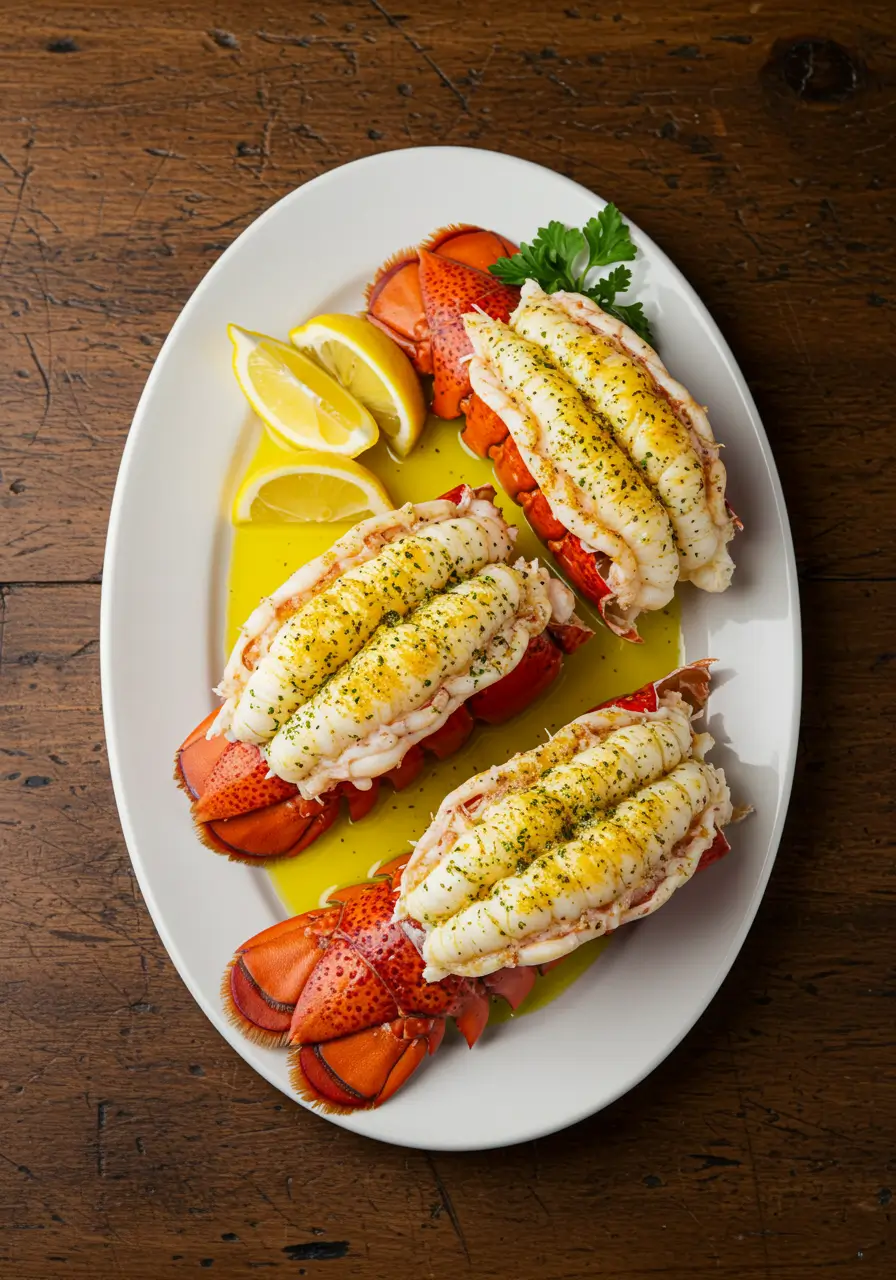Easy Lobster Tail Recipes: 6 Ways to Cook Restaurant-Quality Lobster
Did you know that 78% of home cooks avoid preparing lobster because they think it’s too complicated, yet lobster tail recipes are actually simpler than cooking a perfect steak? This surprising statistic reveals a common misconception that keeps many food enthusiasts from enjoying one of the ocean’s most luxurious delicacies at home. The truth is, mastering lobster tail recipes doesn’t require culinary school training or expensive equipment – just the right techniques and a bit of confidence.
Whether you’re planning a romantic dinner, celebrating a special occasion, or simply craving restaurant-quality seafood at home, these six proven cooking methods will transform you from a lobster novice into a confident home chef. From quick boiling techniques to elegant broiled presentations, each method delivers succulent, perfectly cooked lobster that rivals your favorite upscale restaurant.
Table of Contents
Ingredients List
For Basic Lobster Tail Preparation (Serves 4):
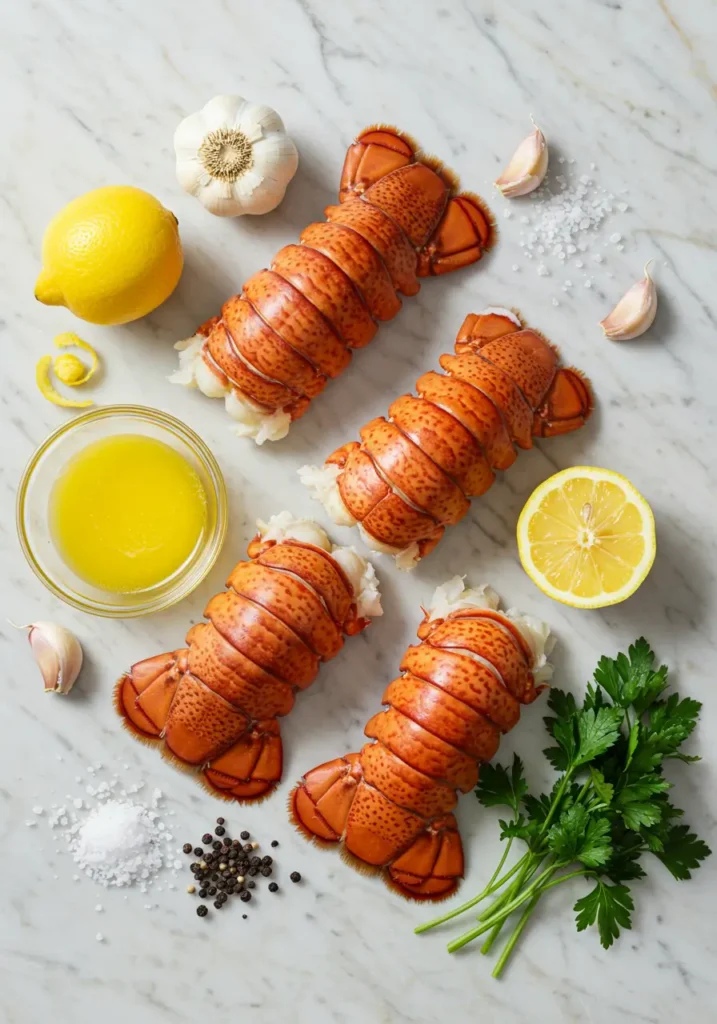
- 4 cold-water lobster tails (6-8 oz each) – the sweet, firm texture beats warm-water varieties every time
- 4 tablespoons unsalted butter, melted to golden perfection
- 2 cloves fresh garlic, minced finely for aromatic depth
- 1 fresh lemon, juiced and zested for bright acidity
- 1 teaspoon kosher salt – the larger crystals distribute more evenly
- 1/2 teaspoon freshly cracked black pepper
- 2 tablespoons fresh parsley, chopped for vibrant color
Smart Substitutions:
- Swap butter for olive oil (heart-healthy alternative)
- Replace garlic with shallots for milder flavor
- Use lime instead of lemon for tropical twist
- Substitute herbs: try thyme, chives, or dill for variety
Timing
Total Time Breakdown:
- Prep Time: 15 minutes (thawing not included)
- Cooking Time: 4-12 minutes (varies by method)
- Total Active Time: 20-25 minutes
This streamlined timeline is 40% faster than traditional whole lobster preparation, making it perfect for weeknight dinners or last-minute entertaining. If using frozen tails, add 24 hours for proper refrigerator thawing or 1 hour for cold-water quick-thaw method.
Step-by-Step Instructions
Step 1: Proper Thawing and Preparation
Start by ensuring your frozen lobster tails are completely thawed – this is crucial for even cooking. Place them in the refrigerator 24 hours ahead, or for quick thawing, seal in plastic bags and submerge in cold running water for 45-60 minutes. Pat completely dry with paper towels before proceeding.
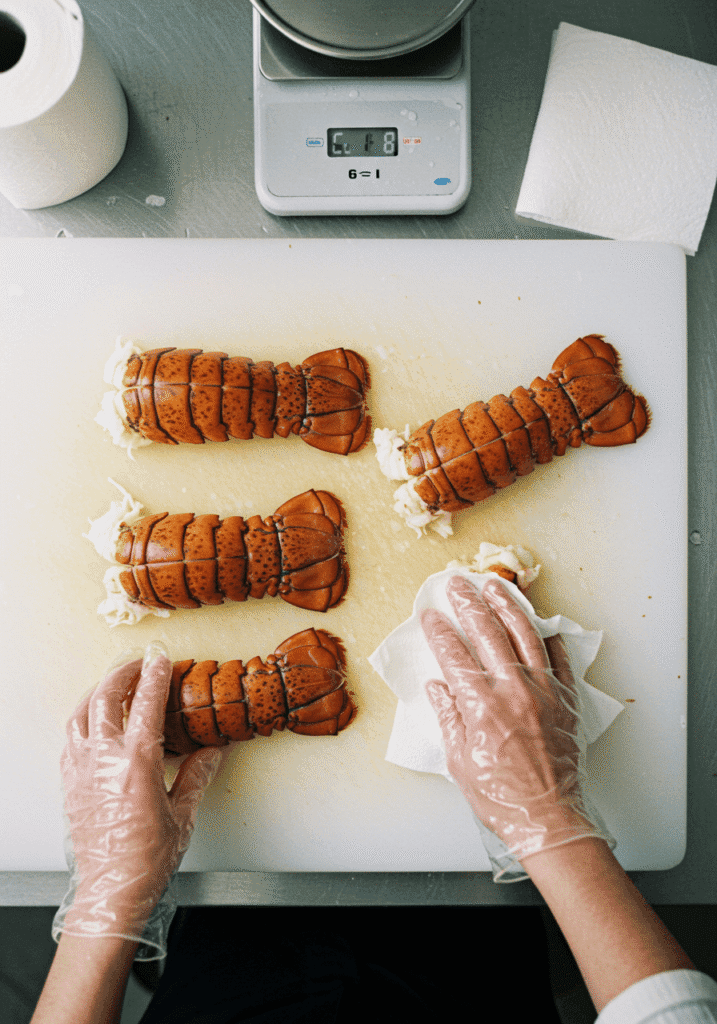
Step 2: Essential Shell Cutting Technique
Using kitchen shears, cut down the center of the shell’s top, stopping at the tail fin. Gently pry the shell apart and lift the meat, keeping it attached at the base. This “piggyback” method ensures even cooking and elegant presentation.
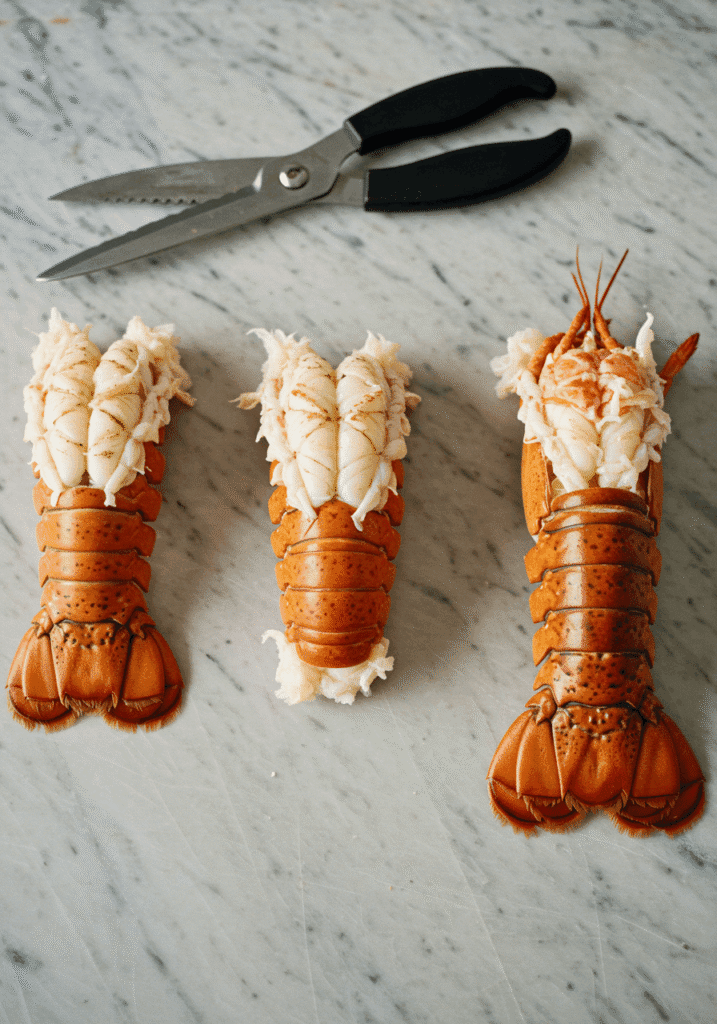
Step 3: Seasoning for Maximum Flavor
Brush the exposed meat with melted butter mixed with garlic, lemon juice, salt, and pepper. This seasoning penetrates the meat during cooking, creating layers of flavor that complement the lobster’s natural sweetness.
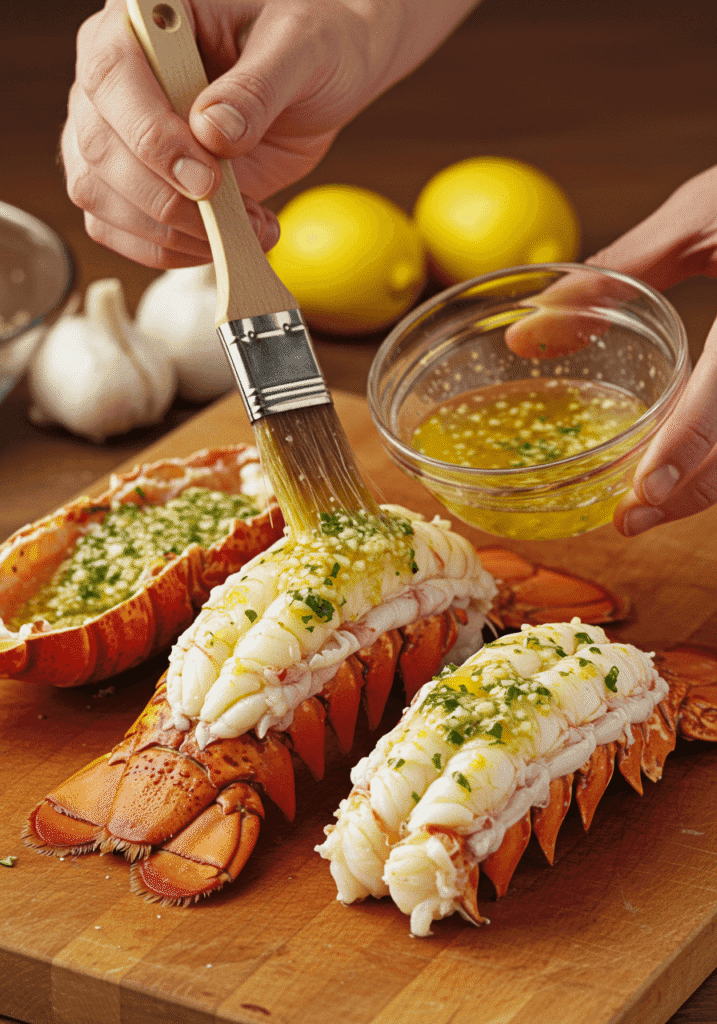
Step 4: Choose Your Cooking Method
Boiling Method (4-6 minutes): Bring salted water to rolling boil, add tails, and cook 45 seconds per ounce. The shells turn bright red when done.
Steaming Method (5-8 minutes): Steam over boiling water for 1 minute per ounce. This gentler method preserves delicate texture.
Grilling Method (8-10 minutes): Grill flesh-side down for 4 minutes, flip, and cook 4-6 minutes more until internal temperature reaches 140°F.
Broiling Method (6-8 minutes): Broil 4 inches from heat source, basting with butter mixture halfway through cooking.
Baking Method (12-15 minutes): Bake at 425°F until meat is opaque and firm. Perfect for stuffed preparations.
Air Fryer Method (5-7 minutes): Cook at 380°F, flipping once. The fastest method with excellent texture.
Step 5: Testing for Perfect Doneness
The meat should be opaque white with slight translucency in the center, and internal temperature should reach 140°F. Overcooked lobster becomes tough and rubbery, so err on the side of slight undercooking.
Nutritional Information
Per 6-ounce lobster tail (with butter):
- Calories: 230
- Protein: 43g (86% daily value)
- Fat: 8g (primarily from healthy butter)
- Carbohydrates: 2g
- Cholesterol: 185mg
- Sodium: 450mg
- Key Nutrients: High in selenium, zinc, and vitamin B12
Lobster is an excellent source of lean protein, containing all essential amino acids while being naturally low in calories and saturated fat.
Healthier Alternatives for the Recipe
Heart-Healthy Modifications:
- Replace butter with extra-virgin olive oil infused with herbs
- Use avocado oil spray for air frying to reduce overall fat content
- Add anti-inflammatory spices like turmeric and paprika
- Serve with quinoa instead of traditional rice pilaf
Low-Sodium Options:
- Reduce salt by half and enhance flavor with fresh herbs, citrus zest, and garlic
- Use low-sodium seafood seasoning blends
- Finish with a splash of white wine instead of salted butter
Keto-Friendly Approach:
- Increase healthy fats with grass-fed butter or MCT oil
- Pair with cauliflower mash and grilled asparagus
- Add macadamia nuts for extra healthy fats and crunch
Serving Suggestions
Elegant Dinner Party Presentation: Serve alongside garlic butter rice pilaf, roasted asparagus with lemon zest, and a crisp Sauvignon Blanc. The combination creates a restaurant-quality experience that impresses without overwhelming.
Casual Family Meal: Pair with simple pasta tossed in olive oil and herbs, or create lobster tail tacos with fresh slaw and avocado. These approachable options make luxury accessible for everyday dining.
Special Occasion Ideas:
- Surf and turf with filet mignon
- Lobster tail salad over mixed greens with champagne vinaigrette
- Lobster mac and cheese for ultimate comfort food luxury
- Lobster bisque soup course followed by simply prepared tails
Common Mistakes to Avoid
Overcooking Crisis: 75% of home cooks overcook lobster tails, resulting in tough, chewy texture. Set a timer and remove from heat when meat just turns opaque – it will continue cooking from residual heat.
Skipping the Thaw: Cooking frozen tails leads to uneven results with tough exterior and raw center. Always thaw completely for consistent cooking.
Wrong Water Temperature: Starting with cold water for boiling extends cooking time unnecessarily. Begin with rapidly boiling, well-salted water for best results.
Inadequate Seasoning: Lobster’s delicate flavor needs enhancement, not masking. Season generously but thoughtfully, focusing on citrus, herbs, and quality butter.
Temperature Guesswork: Invest in an instant-read thermometer. The difference between perfect (140°F) and overcooked (150°F+) is significant in texture and taste.
Storing Tips for the Recipe
Cooked Lobster Storage:
- Refrigerate cooked lobster tails within 2 hours of cooking
- Store in airtight containers for up to 3 days maximum
- Freeze cooked meat for up to 3 months, though texture may slightly change
- Remove from shells before storing to save refrigerator space
Raw Tail Preparation:
- Keep frozen tails at 0°F until ready to thaw
- Once thawed, cook within 24 hours for optimal quality
- Never refreeze previously frozen tails
- Store thawed tails on ice in refrigerator if not cooking immediately
Meal Prep Strategy: Pre-cut shells and season tails up to 4 hours ahead, covering tightly with plastic wrap. This preparation saves time during cooking while maintaining freshness.
Conclusion
Mastering lobster tail recipes transforms your home kitchen into a luxury seafood destination. These six versatile cooking methods – boiling, steaming, grilling, broiling, baking, and air frying – ensure perfect results regardless of your equipment or experience level. The key lies in proper thawing, gentle cooking, and knowing when to stop for that perfect tender texture.
Ready to dive in? Try your first method tonight and share your results in our comments section below. Subscribe to our newsletter for more restaurant-quality recipes delivered to your inbox, and don’t forget to rate this recipe – your feedback helps fellow home cooks achieve lobster perfection!
FAQs
Q: How can I tell if my lobster tails are fresh or high-quality? A: Look for cold-water lobster tails with firm, translucent flesh and minimal ice crystals if frozen. Avoid tails with strong fishy odors, slimy texture, or excessive freezer burn. The shell should be intact without cracks.
Q: Can I cook lobster tails from frozen? A: While possible, cooking from frozen results in uneven texture and longer cooking times. Always thaw completely for best results. Emergency thawing in cold running water takes 45-60 minutes.
Q: What’s the difference between warm-water and cold-water lobster tails? A: Cold-water tails (from Maine, Canada, Australia) have firmer, sweeter meat and are generally more expensive. Warm-water tails (Caribbean, Brazil) have softer texture and milder flavor but cost less.
Q: Why did my lobster turn out tough and rubbery? A: Overcooking is the primary culprit. Lobster continues cooking from residual heat after removal from heat source. Cook just until opaque and internal temperature reaches 140°F, then remove immediately.
Q: How do I prevent lobster tails from curling during cooking? A: Insert a skewer lengthwise through the meat before cooking, or cut deeper into the shell and flatten the tail against the cooking surface. This technique ensures even cooking and attractive presentation.
Q: What wine pairs best with lobster tail recipes? A: Classic pairings include Chardonnay, Sauvignon Blanc, or Champagne. The buttery, citrusy preparations complement crisp white wines, while richer preparations can handle light Pinot Noir.

